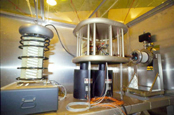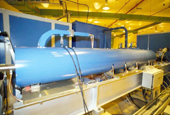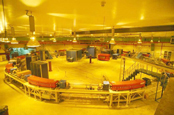What is Synchrotron Radiation ?
Synchrotron Radiation - A Form of Light
" Light" has always been indispensable to man's exploration of nature. All
wavelengths of the electromagnetic spectrum can be referred to as "light".
"Light" of different wavelengths is used for different purposes. The longest
wavelengths, radio waves, are used for observing the expansive universe, and
microwaves are used to detect planes, ships, and typhoons. Infrared light is an
ideal light source for night vision systems and the detection of missiles
through tracking their heat sources. Visible light is the only wavelength
humans can see with their naked eyes. Ultra-violet light is used to examine the
structure of gas molecules and condensed matter. X-rays are the best source for
researching crystal structures; and gamma rays, with the shortest wavelength,
allow researchers to explore the inner world of atoms.
" Synchrotron radiation" refers to a continuous band of electromagnetic
spectrum including infrared, visible light, ultraviolet, and X-rays. This light
has been called "synchrotron radiation", since it was accidentally discovered
in an electron synchrotron of the General Electric Company, USA, in 1947.
Generations of Synchrotron Radiation Sources
Synchrotron accelerators are important tools for researchers of high-energy
physics to study elementary particles. Scientists started to use synchrotron
radiation for various experiments after its discovery at synchrotron
accelerators. Partially dedicated to synchrotron-radiation research, these
high-energy accelerators are called the first-generation synchrotron radiation
sources.
During the 1970's, scientists gradually discovered the many useful
characteristics of synchrotron light, and specialized accelerators were
developed as dedicated light sources. These are the second-generation
synchrotron radiation source.
During the 1980's, scientists invented a method of creating even brighter
synchrotron light. Specially-designed magnets, called wigglers and undulators,
were inserted in storage rings to deflect the electron beam many times over a
short distance. An increase in brightness of over one thousand times could be
achieved through the accumulation of emitted synchrotron light. This advanced
type of synchrotron source is called the third-generation synchrotron light
source. During the 90's, a number of third-generation light sources were built,
including the Taiwan Light Source which began operation in 1993.
The Properties of Synchrotron Radiation
- High Intensity
- Continuous Spectrum
- Excellent Collimation
- Low Emittance
- Pulsed-time Structure
- Polarization
As an example, the intensity of synchrotron X-rays is more than a million times
higher that of X-rays from a conventional X-ray tube. Experiments that took a
month to complete can now be done in only a few minutes. With synchrotron
radiation, molecular structures that once baffled researchers can now be
analyzed precisely, and this progress has opened up many new research fields
over the last few years.
How a Synchrotron Light Source Works
Injector |
Transport Line |
Storage Ring |
Insertion Devices |
Beamlines |
Experimental Station
How is synchrotron radiation produced? Whenever electrons moving close to the
speed of light are deflected by a magnetic field, they radiate a thin beam of
radiation tangentially from their path. This beam is called "synchrotron
radiation". Taking the NSRRC's synchrotron light source as an example, the
electrons are first accelerated in the linear accelerator (LINAC) and the
booster ring (1). They are then sent through the transport line (2) and into
the storage ring (3), where they circulate in vacuum pipes for several hours,
emitting synchrotron radiation. The emitted light is channeled through
beamlines (4) to the experimental stations (5) where experiments are conducted.
(1) Injector (LINAC and Booster Ring)
The injector consists of an electron gun, a LINAC that accelerates the
electrons to an energy of 50 MeV, and a booster (72-meter circumference) that
accelerates the electrons to an energy of 1.5 GeV. The electrons travel at
99.999995% of the speed of light.
| Parameters of Injector
|
| Injection energy |
1.5 GeV |
| Injection cycle rate |
10 Hz |
| Linac energy |
50 MeV |
| Booster circumference |
72 m |
| Booster RF frequency |
499.654 MHz |

Electron gun

LINAC

Booster ring
(2) Transport Line
After reaching the target energy, the electrons are transferred from the booster ring to the storage ring through a 70-meter-long transport line.
(3) Storage Ring
The storage ring is roughly hexagonal in shape and has a circumference
of 120 meters. Electrons with an energy of 1.5 GeV circulate in an
ultra-high-vacuum chamber. A series of magnets situated around the ring steer
the electrons along circular arcs, and synchrotron radiation is continuously
emitted tangentially from the arcs.
|
Parameters of Storage Ring |
| Maximum energy |
1.5 GeV |
| Maximum beam current, multibunch |
300 mA |
| Maximum beam current, single bunch |
25 mA |
| Beam lifetime (1.5 GeV, 200 mA) |
> 9 h |
| Circumference |
120 m |
| Orbital period |
400 ns |
| Number of superperiods |
6 |
| Lattice type |
Triple bend achromat |
| Natural horizontal beam emittance |
2.5 x 10 -8 m-rad |
| RF frequency |
499.654 MHz |
| Harmonic number |
200 |
| Bending radius |
3.495 m |
| Critical photon energy |
2.14 keV |
| Bunch length ( 1σ ) |
25 ps |
| Maximum length of insertion devices |
4.5 m |
(4) Insertion Devices (wigglers/undulators)
Insertion devices comprise of rows of magnets with alternating
polarity, and produce brighter synchrotron radiation by causing the beam to
oscillate.
Wigglers :
cause multiple direction changes (or wiggles) in the electron beam that
generate extremely bright white light with short wavelengths.
Undulators :
cause periodic changes in the electron beam's direction that produce
ultra-brilliant, single-wavelength radiation from the resulting interference
patterns.
(5) Beamlines
The beamlines house many specially-designed optical components which
provide focused synchrotron radiation of the desired energy into users'
experimental end stations.
(6) Experimental Station
Experiments using synchrotron radiation attempt to analyze electrons,
photons, and other particles that are emitted when synchrotron radiation
strikes matter. The resulting data are then used to deduce the matter's
chemistry, geometry, electronic structure, or magnetic properties.